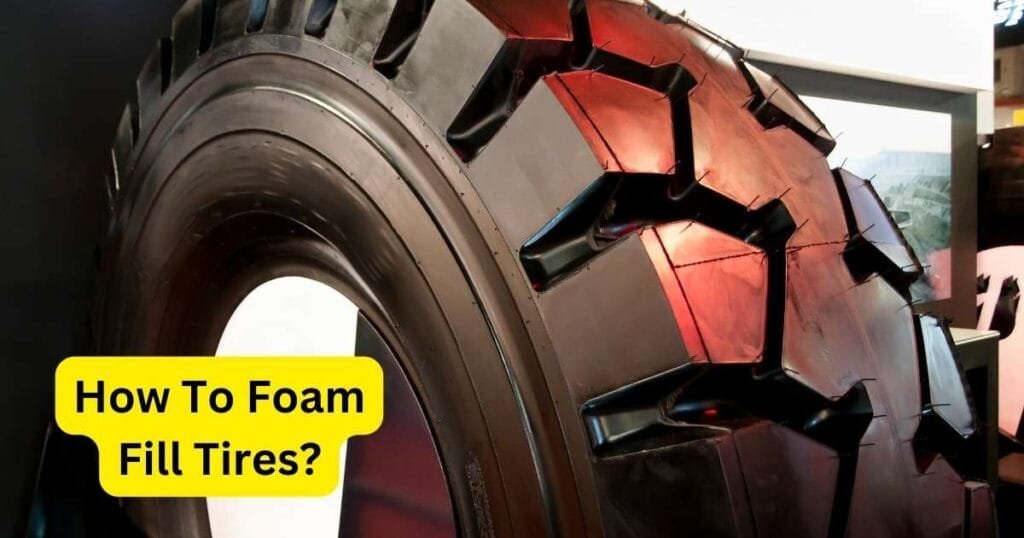Flat tires can be frustrating. Dealing with a puncture is never fun, whether on your bicycle or wheelbarrow. It can mess up your plans for the day and leave you stuck.
But there’s good news! Foam-filled tires are here to help. These tires don’t use air, so you won’t have to worry about getting a flat tire anymore.
Knowing how foam works and what it’s suitable for is essential before you decide to fill your tires with it. Foam-filled tires are an excellent solution for avoiding flat tires.
They’re different from regular tires because they don’t need air to stay inflated. This means you won’t have to deal with punctures or flats anymore, which can save you a lot of hassle.
But there are some things you should know before you switch to foam-filled tires. Let’s examine how they work and when they’re best used.
Table of Contents
How To Foam Fill Tires?
Foam-filling injects liquid polyurethane foam into a tire’s inner cavity, replacing the need for air and providing a puncture-resistant solution.
The tire is removed from the vehicle to foam fill tires and inspected for any existing damage. Next, all air is evacuated from the tire cavity, and the foam is injected evenly throughout.
The foam then expands and cures, forming a solid, durable structure that adheres to the tire’s inner liner. After curing, the tire is rebalanced and remounted onto the vehicle.
This method eliminates the risk of flats caused by punctures, enhances stability, and reduces maintenance needs, making it ideal for various industrial and recreational applications.
What is Foam-Filling?
Foam-filling is the process of injecting liquid polyurethane foam into the inner cavity of a tire. This liquid expands and cures into a solid. Elastic substance replacing the air that keeps the tire inflated.
The cured foam forms a permanent bond with the tire’s inner liner. We are eliminating the possibility of flats caused by punctures or leaks.
There are two main types of foam used for tire filling:
High-density foam
This type creates a very rigid structure within the tire, like a solid rubber tire. It’s ideal for applications where puncture resistance and stability are paramount.
Such as industrial vehicles operating on uneven or hazardous terrain. However, the high rigidity can compromise ride quality and handling.
Low-density foam
This type offers a more balanced approach. It provides excellent puncture resistance while maintaining some air cushioning, resulting in a smoother ride than high-density options.
It’s famous for applications like wheelbarrows, hand trucks, and utility vehicles.
What Are the Benefits of Foam-Filled Tires?
There are several compelling reasons to consider foam-filling your tires:
Flat-Proof Performance
The primary advantage is the elimination of flats. With no air to lose, you can conquer punctures and leaks without ever having to stop and inflate. This translates to increased productivity, reduced downtime, and peace of mind.
Reduced Maintenance
Since flats are a non-issue, you’ll spend less time maintaining your tires. This includes the time and effort required for regular pressure checks and patching punctures.
Improved Stability
Foam filling can enhance the stability of a vehicle, particularly for applications like wheelbarrows or utility carts that carry heavy loads.
The solid structure of the foam helps prevent tire flex and maintains consistent ground clearance.
Weight Distribution
Foam-filled tires can contribute to better weight distribution on a vehicle. This can be beneficial for applications where precise handling is crucial.
What Are Applications for Foam-Filled Tires?
Foam-filled tires are a versatile solution across various applications:
Industrial Equipment
Forklifts, scissor lifts, and other industrial vehicles operating in harsh environments with a high risk of punctures benefit from foam-filled tires. The puncture resistance ensures continued operation and minimizes downtime.
Lawn and Garden Equipment
Wheelbarrows, lawnmowers, and utility carts used for yard work often encounter thorns, nails, or other debris. Foam-filled tires eliminate the worry of flats in these scenarios.
Recreational Vehicles
Golf carts, all-terrain vehicles (ATVs), and utility terrain vehicles (UTVs) can leverage foam-filled tires for enhanced puncture resistance. Especially when venturing off-road.
Puncture-Prone Applications
Applications with a high likelihood of punctures, such as hand trucks used in construction or warehouses, can benefit significantly from foam-filled tires.
What are the things to consider before foam-filling?
While foam-filling offers many advantages. It’s essential to weigh the pros and cons before making a decision. Here are some key factors to consider:
Ride Quality
Foam-filled tires, particularly those with high-density foam. They can compromise on ride quality due to their reduced air cushioning. This may be less noticeable in industrial applications but can be a factor for comfort-oriented uses like bicycles.
Handling
The solid structure of foam-filled tires can impact handling characteristics, especially at higher speeds. Certain vehicles may require adjustments to their driving styles.
Tire Size and Type
Foam-filling is generally not recommended for large, high-speed tires used on passenger cars or motorcycles. It’s better suited for smaller tires with lower operating speeds.
Cost
Foam-filling can be more expensive than traditional tire maintenance. The long-term benefits, like reduced flat repairs and extended tire life, can offset the initial cost.
Reversibility
In most cases, foam-filling is a permanent modification. Removing the foam for repairs or replacing the tire is often difficult or impossible.
What is the Process of Foam-Filling Tires?
Foam filling, while straightforward, requires specific equipment and expertise. Here’s a simplified overview of the professional process:
1. Tire removal: The tire is removed from the vehicle and inspected for existing damage.
2. Air removal: All air is removed from the tire cavity.
3. Foam injection: The chosen foam is injected into the tire through a specialized valve, ensuring even distribution.
4. Curing time: The foam can cure and solidify according to the manufacturer’s specifications.
5. Rebalancing and remounting: The tire is rebalanced to account for the added weight and remounted on the vehicle.
Important Note: This is a simplified overview, and the actual process may vary depending on the specific foam type, equipment used, and tire size. Always consult a qualified tire professional for proper assessment and installation.

What are Additional Considerations?
Before making your final decision, consider these additional factors:
Cost: Foam filling costs more than traditional air-filled tires, with professional installation adding to the expense.
Environmental impact: Some foam types may have a higher ecological impact than natural rubber tires. Research and choose eco-friendly options if possible.
Regulations and warranties: Check if foam filling affects your vehicle’s warranty or violates local laws.
Conclusion
Foam filling your tires offers a compelling solution for puncture-proof peace of mind, particularly for industrial and specific applications. However, weigh the pros and cons. Consider your needs and vehicle compatibility, and consult a qualified tire professional before deciding. Remember, informed choices lead to smoother, safer rides down the road.
FAQs
What Are the Benefits of Foam-Filled Tires?
The primary advantage of foam-filled tires is the elimination of flats, which increases productivity and reduces downtime. Foam-filled tires require less maintenance, enhance vehicle stability, and improve weight distribution, which is important for precise handling.
What Are Applications for Foam-Filled Tires?
Foam-filled tires are ideal for industrial equipment like forklifts and scissor lifts, lawn and garden equipment such as wheelbarrows and lawnmowers, and recreational vehicles including golf carts and ATVs.
What is the Process of Foam-Filling Tires?
The process involves removing the tire, evacuating air from the cavity, injecting the foam evenly, allowing it to cure, and then rebalancing and remounting the tire on the vehicle.


